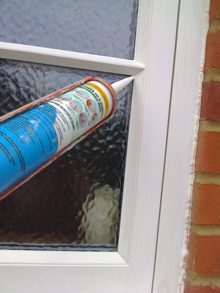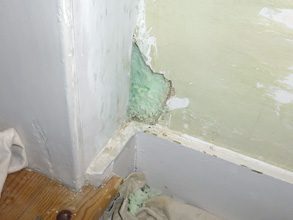Acrylic Mastics, frame sealants or Decorator’s caulk – These are excellent products that have been around now in one form or another for over twenty five years and have completely replaced the old powder fillers on certain areas of making good.
 If used within their limits they produce a flexible and long lasting repair. Lots of different makes are available; they are cheap, clean and easy to use. They can be brought at any of the DIY stores in two or three colours and are designed to be either painted or stained.
If used within their limits they produce a flexible and long lasting repair. Lots of different makes are available; they are cheap, clean and easy to use. They can be brought at any of the DIY stores in two or three colours and are designed to be either painted or stained.
You can use these to fill up gaps and cracks in between door frames, skirting boards and walls or anywhere there is an angled gap to be filled. Exterior grades ones are also available. They are flexible and will not crack when slight movement occurs unlike fillers which set hard.
To get mastics to perform and last you need to do a couple of things, firstly do not apply it to any bare surfaces i.e. bare wood or plaster as the mastic will eventually come away from the surface that has the poorest adhesion and pull up in long ribbons, so prime all bare surfaces prior to filling with the appropriate primer. Also allow it to set properly, over night is best if you have time to do so or if not at least half a day. I know on the tube it says it can be painted on in one hour and applied straight to bare surfaces but in reality it cannot.
Mastics can be used successfully as long as the gaps to be filled are not too large, I would personally say not much bigger than 8 millimetres wide and then that’s quite a big gap to fill with mastic. Small gaps of 2mm or 3mm are much better and always fill well if surfaces are painted. If the gaps are large, you should try and reduce them down wherever possible to a size that can be successfully filled either by pulling in ill fitting skirting boards or architraves with extra screws. If that is not possible, then back fill with flexible materials like expanding foam or a first layer of mastic. Allow it to set and fill again. Do not back fill with plaster based fillers as they will crack and are very powdery when dry, which will cause the mastic to fail if it is applied over the top.
Cut out old fillers and mastics that have cracked or failed, rub down the surrounding areas so they are smooth, prime bare areas and re-apply fresh mastic, then paint over when set.
 Very large gaps or voids behind such things as old skirting boards should always be back filled with expanding foam then cut back below the surface and over filled (see image left). Do not use the old fashioned method of tightly rolling up old pieces of newspapers and stuffing it into the void, this never works.
Very large gaps or voids behind such things as old skirting boards should always be back filled with expanding foam then cut back below the surface and over filled (see image left). Do not use the old fashioned method of tightly rolling up old pieces of newspapers and stuffing it into the void, this never works.
Lastly do not confuse acrylic based sealants mentioned above with silicone based sealants, which you use around your kitchen worktops, tiles, around baths and basins or plastic windows etc. to make waterproof seals. Whatever you do, do not use these silicone based sealants for general making good, they DO NOT accept being painted at all, especially water based paints, even if it does say so on the tube! I know that builders and window fitters use it for everything, even making good to plaster, but be warned it is incredibly difficult to remove and it is impossible to paint over and get a good finish!
FOOTNOTE: There is now a fully paintable Silicone based mastic on the market called C.T.1., comes in white & clear and can be successfully overpainted with oil or water based paint. Very good new product, but expensive.

